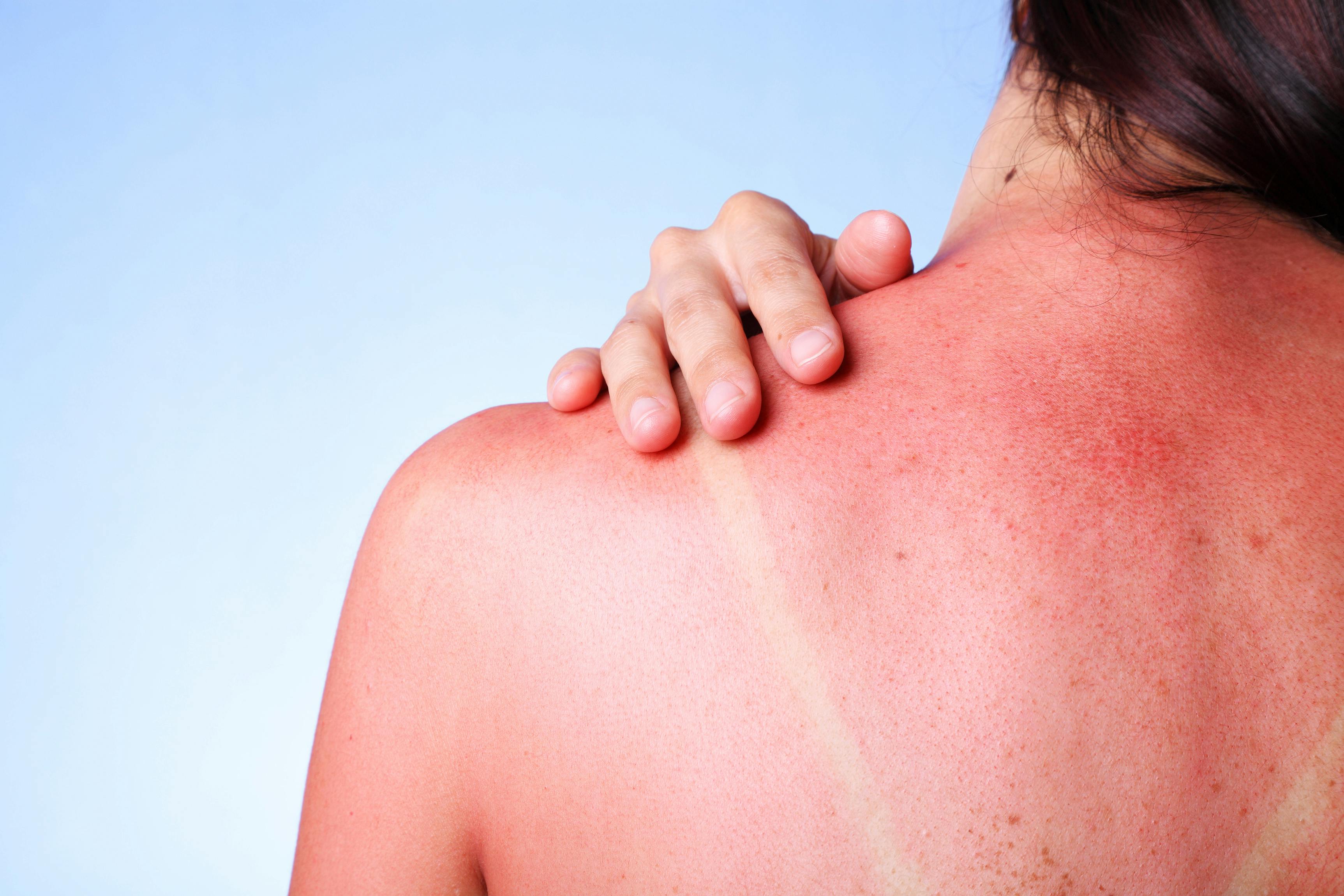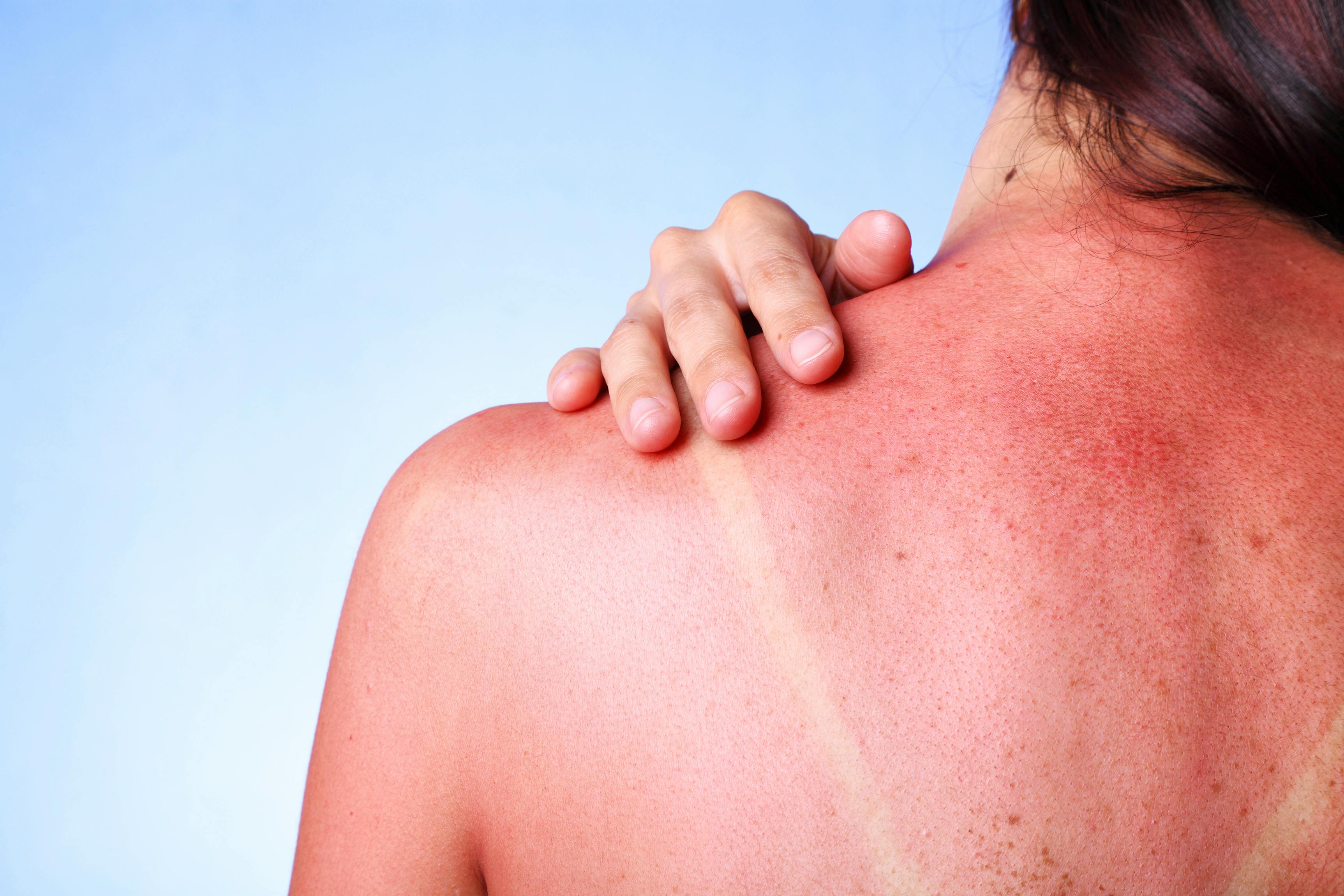Over one-third of adults in the United States report getting sunburned each year. Sunburns are not only painful but are a common result of overexposure to ultraviolet (UV) radiation, potentially causing significant skin damage. That’s why understanding the causes, symptoms, treatment options, and ways to prevent sun damage is essential for maintaining healthy skin and avoiding long-term harm.
What is Sunburn?
A sunburn is a type of skin burn resulting from too much exposure to ultraviolet (UV) radiation, typically from the sun but also from artificial sources like tanning beds. This overexposure disrupts the normal function of the skin's cells, leading primarily to the visible redness, which is an indication of damage to the deeper layers of the skin.
As the body's defense mechanism against further UV damage, sunburn may trigger the production of more melanin, the dark pigment in the epidermis intended to protect skin by absorbing UV radiation.

How Does Sunburn Affect the Skin?
Excessive exposure to ultraviolet (UV) radiation overwhelms the skin’s natural defense mechanisms, leading to visible damage and inflammation. The body's response to this damage manifests in several ways:
- Inflammatory Response: The skin reacts by becoming red, swollen, and tender due to increased blood flow to the affected area.
- Severity Levels: A mild burn causes slight redness and irritation, while deep burns may result in intense pain, swelling, and blisters.
- Cellular Damage: UV radiation directly harms the DNA of skin cells, disrupting their normal function and heightening the risk of long-term complications.
- Chemical Release: Damaged cells trigger the release of inflammatory chemicals, causing blood vessels to expand and intensify the sensation of heat and discomfort.
Beyond immediate irritation, repeated sunburns contribute to premature skin aging and significantly elevate the risk of skin cancer over time. Studies show that experiencing five or more sunburns doubles an individual's risk for melanoma.
Beyond immediate irritation, repeated sunburns contribute to premature skin aging and significantly elevate the risk of skin cancer over time. Studies show that experiencing five or more sunburns doubles an individual's risk for melanoma. In fact, having as few as five sunburns over a decade—or even just one sunburn every ten years—can result in up to triple the risk of developing melanoma.
What Causes Sunburn?
Sunburn occurs when UV radiation exposure surpasses the skin’s natural protective abilities, leading to cellular damage. Melanin helps absorb some UV rays, but when exposure exceeds its capacity, the skin becomes inflamed and irritated. While sunlight is the most common source, artificial UV radiation from sunlamps and tanning beds can also cause burns. Factors such as the UV index, altitude, and geographic location play a key role in determining exposure levels.
Signs & Sunburn Symptoms
The signs and symptoms of sunburn often vary widely from mild to severe, depending on the extent of UV radiation exposure and an individual's skin type. For this reason, the sooner you recognize these symptoms, the faster you can find relief through treatment.
Mild Sunburn Symptoms
A mild sunburn develops after prolonged UV exposure. While mild sunburns usually heal on their own, proper care can help relieve symptoms and support skin recovery.
- Redness and Warmth – The affected skin may appear pink or red and feel warm to the touch.
- Tenderness or Sensitivity – Sunburned areas may become sore or sensitive, especially when touched or exposed to heat.
- Tight or Dry Skin – The skin may feel tight, stretched, or dry due to moisture loss from excessive sun exposure.
- Mild Itching or Irritation – Some people experience itching as the skin reacts to UV damage.
- Peeling Skin – A few days after the burn, the top layer of skin may begin to peel as the body sheds damaged cells.
- Slight Swelling – In some cases, mild sunburn can cause minor swelling in the affected area.
Most mild sunburns heal within a few days with proper care, including hydration, moisturization, and limiting further sun exposure. However, if symptoms worsen, become increasingly painful, or do not improve, consider consulting with a dermatologist for further evaluation and treatment.
Severe Sunburn Symptoms
Prolonged or intense UV exposure can lead to an intense sunburn, resulting in noticeable pain and skin damage. Symptoms include:
- Blistering Skin – Fluid-filled blisters may form on the affected areas, indicating deeper skin damage.
- Intense Pain and Tenderness – The burned skin may be extremely sensitive, painful to the touch, and uncomfortable even while at rest.
- Extensive Redness and Swelling – The skin may appear deep red and inflamed, with noticeable swelling that may worsen over time.
- Fever and Chills – A high temperature, chills, or shivering can signal a more serious reaction to UV exposure.
- Nausea and Fatigue – Some individuals may feel weak, dizzy, or nauseous due to dehydration and the body's response to skin damage.
- Headache and Dizziness – Sunburn-related dehydration may cause headaches, dizziness, or lightheadedness.
When to See a Doctor for Sunburn
The decision to see a doctor for sunburn depends on the severity of your symptoms. Certain signs indicate the need for immediate attention, such as severe blistering over a large area, signs of infection like pus or increasing redness, or systemic symptoms like fever, chills, or confusion.
Sunburn Treatment & Relief Options
Since sunburns can be so painful and uncomfortable to deal with, finding the right treatment is important. The following strategies help soothe irritated skin, reduce inflammation, and support the healing process, ensuring a faster and more comfortable recovery.
Cool Compress & Hydration
To help calm irritation and reduce inflammation, start by applying a cool compress to sunburned areas. This simple remedy soothes the skin and reduces inflammation. Along with external relief, staying hydrated is key, as sunburn draws fluid to the skin’s surface, increasing the risk of dehydration. Drinking plenty of water supports the body’s healing process and helps replenish lost fluids.
Aloe Vera & Moisturizers
Apply aloe vera or moisturizing lotions to provide relief and help hydrate the skin. These products aid in the healing process. However, be sure to avoid petroleum-based products, which can trap heat in the skin and exacerbate the burn.
Pain Relief Medications
Over-the-counter pain relievers like ibuprofen or Tylenol can decrease pain and inflammation. Follow the directions on the label and consider using these medications during the initial days following a sunburn for optimal relief.
Treating Sunburn Blisters
Refrain from popping blisters to lower the risk of infection. Should blisters break naturally, gently clean the area with water and mild soap. Afterwards, apply an antibiotic ointment and cover with a nonstick gauze bandage to protect the area.
How to Prevent Sunburn
Sunscreen
Sunscreen is one of the best ways to shield your skin from sunburn and the lasting effects of UV exposure. For optimal protection, choose a broad-spectrum formula with an SPF of 30 or higher. Apply a generous amount at least 30 minutes before heading outdoors, even on cloudy days, and reapply every two hours or immediately after swimming or sweating for extra protection.
One of the most frequent mistakes is not applying enough sunscreen—many people use far less than needed to achieve the labeled SPF protection, leaving their skin vulnerable to UV damage.
UV Protective Clothing & Shade
Wearing UV-protective clothing, wide-brimmed hats, and wraparound sunglasses helps shield your skin and eyes from harmful ultraviolet rays. For additional protection, seek shade—especially during peak sunlight hours from 10 AM to 3 PM, when UV radiation is at its highest. Avoiding direct sun exposure during these hours can significantly reduce your risk of sunburn.
Sun Safety
Ultimately, adopting a comprehensive approach to skin care helps prevent sunburn and minimize lasting skin damage. Use sunscreen, wear protective clothing, and limit sun exposure during peak hours to keep your skin safe from harmful UV rays.
FAQs
The most effective immediate treatment for sunburn is to cool the skin using cool baths or compresses, apply moisturizing creams with aloe vera, and take pain relief medication as needed to reduce discomfort and inflammation.
Sunburn can last for several days, depending on its severity. Mild sunburns might heal within a few days, whereas severe ones could take longer and might peel or blister.
Cool baths, aloe vera, and over-the-counter pain medications help when trying to quickly alleviate sunburn pain. You can also support the healing process by keeping the skin moisturized and limiting sun exposure.
You should see a doctor if you experience extreme blisters, high fever, intense pain, signs of infection, or if the sunburn covers a large portion of your body.
Yes, even one sunburn can raise the risk of skin cancer, including melanoma. Repeated sun exposure and multiple sunburns over time further elevate this risk, emphasizing the need for proper sun protection.

